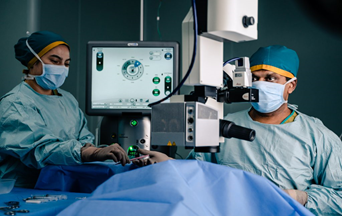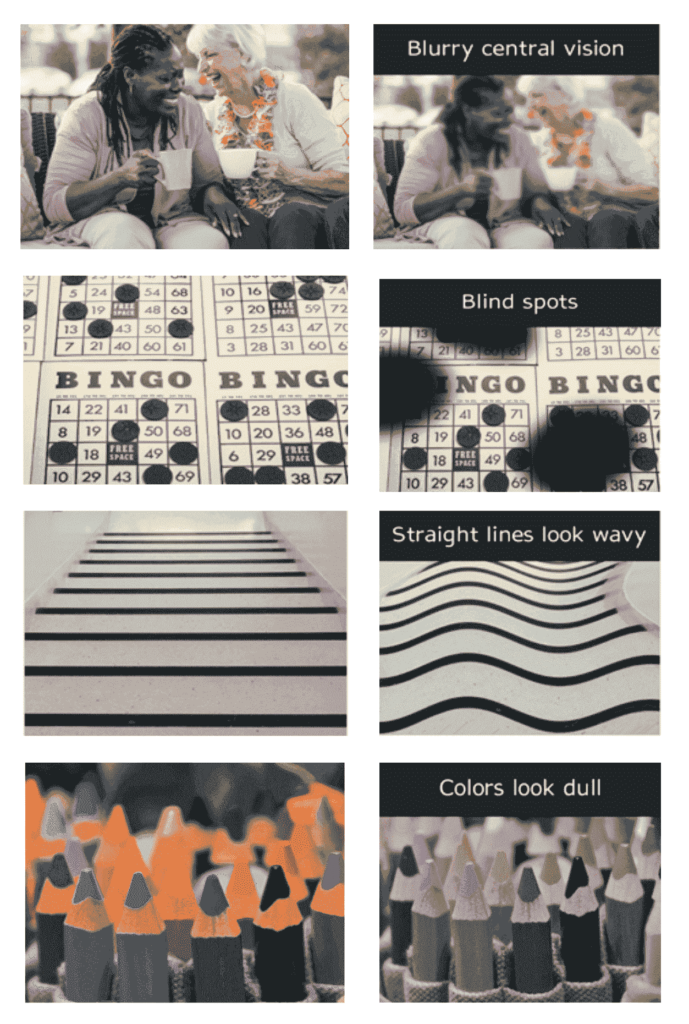
1. Age-related Muscular Degeneration (AMD) And Vision Loss
According to Cleaveland Correction Eye Center, age-related muscular degeneration (AMD) does not cause complete blindness in the patient. However, studies show that AMD causes patients to lose central vision, making it harder to see faces read, and even perform close-up tasks such as cooking and fixing stuff around the house. The slow progression of the disease makes it hard to notice at first, making vision loss detectable after a very long time. The prominent risk factor for losing vision for patients with AMD is aging which starts at the age of 50 years. Other risk factors include using narcotics such as smoking, underlying health conditions such as high blood pressure, and consuming a diet with a high concentration of saturated fats. Muscular degeneration causes patients with AMD to have blurred and central vision loss caused by the thinning of the macula. While it is difficult to comprehend how it is living with the condition, the following images show how patients with AMD live with the condition having their vision distorted. In other instances, patients may experience straight lines appearing wavy or have bling spots within the visual fields. Furthermore, in other instances, patients may have changes in color perceptions as the disease weakens the photoreceptor cones responsible for color perception. While AMD can lead to severe vision loss to central vision, it is rare for people to go bling from the condition.

2. Diagnosis for Age-related Macular Degeneration (AMD)
There are several tests that an ophthalmologist will recommend and apply to diagnose muscular degeneration fully. Diagnosis for AMD involves the examination of the back of the patient's eye. The physician often puts drops in the patient's eye to dilate them and then uses special equipment to examine the back of the eye.
According to John Hopkins Medicine Center, with 80% of people diagnosed with AMD having dry AMD. Dry AMD occurs when parts of the macula shrink with aging and tiny clumps of proteins known as drusen grow. Wet AMD is a more severe form of the disease which happens when new and abnormal blood vessels grow beneath the retina. This form of AMD causes the patient to lose their vision faster compared to dry AMD. AMD is hard to diagnose; hence patients with suspected symptoms are requested to check in with their ophthalmologists regularly. Imaging and blood tests are used to determine abnormality in the dilation of the blood vessels and bleeding taking place for patients with wet AMD.
3. Treatment of Age-related Macular Degeneration (AMD)
Treatment options for AMD include anti-angiogenic drugs, laser therapy, photodynamic laser therapy, and low-vision aids. There are also some experimental new pharmacological approaches, including treated with a high-dose combination of vitamin C, vitamin E, betacarotene, and zinc can reduce the risk of developing advanced AMD almost 25%, and reduce the risk of vision loss caused by advanced AMD by about 19%.
4. What are the best medical interventions for macular degeneration condition?
Macular degeneration surgery is a type of laser photocoagulation used to treat AMD. In this procedure, the physician will rotate the center of the macula away from the abnormal blood vessel to a healthier area within the retina, which helps prevent the patient from developing scar tissue that damages the retina. The doctor will then use a laser to treat the abnormal blood vessels.
Side effects of Macular Degeneration Surgery
The central question patients diagnosed with AMD ask is what the side effects are or what to expect from muscular degenerative surgery. After the muscular degenerative surgery, patients will have a swollen eye with red spots and feel tender for several weeks. The pain will eventually subside, and the vision will be blurry for a few days. The patient will need two to four weeks to recover from the effects of the surgery to regain normalcy.
Surgical Cost for Macular Degeneration Surgery
For patients not covered by health insurance, the average cost for treating AMD using macular degeneration surgery typically costs $9000-$65000, depending on the prescriptions required for the patient. Other costs incurred after the surgery include the two-year course of treatment on injection drugs to inhibit the eye from excessive leakages. The two-year injection plan will cost an additional $10000.
5. Eye Nutrition Supplements for Age-related Macular Degeneration (AMD)

According to recent findings, both wet and dry AMD can be managed through a unique combination of particular vitamins and minerals known as AREDS2, which studies confirm slows down the progression of the condition. The combinations for these vitamins and minerals contain at least zeaxanthin, vitamin C, vitamin E, zinc oxide, and cupric oxide. For example, if the patient has been diagnosed with intermediary AMD for either or all of their eyes, they will consume special dietary supplements that primarily contain vitamins and minerals to stop the stage from turning into late AMD. Nevertheless, when the patient is diagnosed with late-stage AMD in one eye, the available supplements will only slow down AMD from progressing to the other eye.
Learn More: What is Macular Degeneration AMD?
6. Low Vision Products for Age-related Macular Degeneration (AMD)
Advances in technology and the development of visual aid products from Zoomax, eSight, OrCam, etc. make it possible for patients with AMD and with low vision to live and work similarly to people with normal vision. Products of handheld electronic magnifiers, such as the Zoomax Luna series, like Luna S, Luna 6, and Luna 8, wearable assistive technology Acesight series, which positively applied many cutting-edge technologies, that enable people living with AMD to see more explicit images even in poor lighting conditions. Low-vision products of desktop electronic video magnifiers include the newly presented Luna HD 24 Pro, Aurora HD, Supernag 6, etc., also gain great customer feedback.
References

